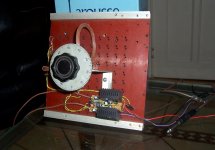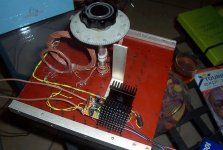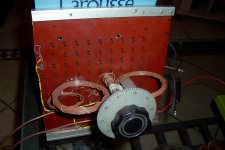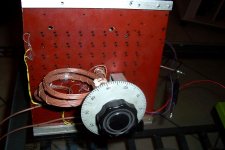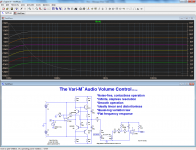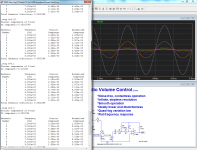
Here is a new idea for volume control: it uses the principle of
 variable magnetic coupling
variable magnetic coupling 

The coils used are air-cored, meaning they introduce no distortion. 😎
Obviously, there has to be a frequency correction, but this is pretty straightforward, it is essentially a first order compensation.
The prototype is a proof-of-concept demonstrator, bulky, open and unshielded, for real applications the coils should be made with proper wire, not PVC covered wiring cable, have sufficient turns, and the assembly should be enclosed in a shield.
The values on this prototype are preposterous for audio: the coils only have 35t and 25t, with correspondingly low inductances (I made them first, measured them and made calculations and design around them) .
The transmit L/R time constant results in a 13KHz corner frequency, meaning there has to be a huge correction and a hefty Tx side amplifier.
Even so, the prototype works exceedingly well, with a nice and smooth variation, a perfect null thanks to a small auxiliary coil and a perfect audio transparency. Very pleasant!
The overall gain is much larger than 0dB at the maximal volume, a resistive pad is included at the output to restore the level and reduce the noise.
Other strategies would be possible.
Have fun!!

Attachments
When you get fed up with it as a volume control you can convert it into a crystal set or an LF ATU.
Just like Dr.Wily would, lacking some robotic arm controlled by remote to regulate the knob though, would also be neet if you made the same robotic arm change input by toggle switches.
Volume down, toggle cd left off, toggle cd right off, toggle lp left on, toggle lp right on, lp player start, volume up
Volume down, toggle cd left off, toggle cd right off, toggle lp left on, toggle lp right on, lp player start, volume up
Last edited:
I wasn't aware that particular wheel had been invented.Now that is reinventing the wheel!
Can you provide an example of such a volume control? (I mean not the plain old autoformer type)
Varying coupling between circuits by moving/rotating a coil was used in early TRF radio sets for adjusting reaction, I think. It may not have been used for volume because it is not a good way to do it. It is easy to be first to invent a bad idea!
Compared to some alternatives volume control schemes, of which a number have been presented here, this idea looks rather sound, dull and rationalIt may not have been used for volume because it is not a good way to do it. It is easy to be first to invent a bad idea!
Well heres the problem that I have with it.
I'm actually in the market for a good quality volume control inorder to go between or after my recently built TDA1543 DAC and a tube preamplifier.
I have the rather excellent and easy to find/purchase/install option of the Resistor based selector switch style of volume control.
Or I could go for a pot, which I'm not going to because I want the best here.
I don't want my sound to be muddled, I don't want my sound to be touched in any way, I am afterall considering spending a hundred bucks or so on a bag of good resistors and a high quality copper double gang selector switch.
What does your rather interesting project have to offer? it might have perfect linearity in a simulation but it doesn't in real life, I assure you of that.
More to that point (linearity), I am as of monday of next week purchasing a $1,000 OTL tube amplifier kit from Transcendent Sound, OTL means that it has no output transformer.
An output transformer colours the sound, and some people have spent many tens of thousands of dollars on just 1, made out of pure silver wire and some of the finest hand ground japanese iron cores, which are then rested in-between the breasts of a lovely japanese schoolgirl for 3-5 weeks.
Now I don't know about you but where and why exactly would I want to use a magnetically coupled volume control? which could quite easily pickup the magnetic field of a transformer, or a wire in the wall behind it, or the television set SMPS power supply.
You sir have built a radio more than a volume control, a volume control is transparent and passive, this, conceivably with a diode in the right place, could make a fine radio.
And that is what I mean by reinventing the wheel. Enjoy your invention, it looks nice and could even do good in the right place, a tube radio.
I'm actually in the market for a good quality volume control inorder to go between or after my recently built TDA1543 DAC and a tube preamplifier.
I have the rather excellent and easy to find/purchase/install option of the Resistor based selector switch style of volume control.
Or I could go for a pot, which I'm not going to because I want the best here.
I don't want my sound to be muddled, I don't want my sound to be touched in any way, I am afterall considering spending a hundred bucks or so on a bag of good resistors and a high quality copper double gang selector switch.
What does your rather interesting project have to offer? it might have perfect linearity in a simulation but it doesn't in real life, I assure you of that.
More to that point (linearity), I am as of monday of next week purchasing a $1,000 OTL tube amplifier kit from Transcendent Sound, OTL means that it has no output transformer.
An output transformer colours the sound, and some people have spent many tens of thousands of dollars on just 1, made out of pure silver wire and some of the finest hand ground japanese iron cores, which are then rested in-between the breasts of a lovely japanese schoolgirl for 3-5 weeks.
Now I don't know about you but where and why exactly would I want to use a magnetically coupled volume control? which could quite easily pickup the magnetic field of a transformer, or a wire in the wall behind it, or the television set SMPS power supply.
You sir have built a radio more than a volume control, a volume control is transparent and passive, this, conceivably with a diode in the right place, could make a fine radio.
And that is what I mean by reinventing the wheel. Enjoy your invention, it looks nice and could even do good in the right place, a tube radio.
Last edited:
Now if you want something to really build, build a vacuum tube volume control.
One that has the input going to the cathode, output going to the plate, and a grid inbetween which is energized by a DC voltage inorder to "steal" the flow of electrons flowing from the cathode to the plate.
Woops, already been done: 6BE6 volume control
One that has the input going to the cathode, output going to the plate, and a grid inbetween which is energized by a DC voltage inorder to "steal" the flow of electrons flowing from the cathode to the plate.
Woops, already been done: 6BE6 volume control
That is a completely gratuitous and unsupported assertion.What does your rather interesting project have to offer? it might have perfect linearity in a simulation but it doesn't in real life, I assure you of that.
The distortion you see in the sim is almost completely caused by the output integrator because of the silly ~100µH value of the coils.
The LT1056 is not particularly low THD, and the values around it have not been optimized. But the value shown is highly realistic, because (unsurprisingly) LT parts are very well modelled in LTspice
With realistic coils, a good audio opamp and a little care, ppm levels could easily be reached. Not only in sim, but in reality too.
The linearity of the core itself excluding the semiconductors is practically infinite: if there are no ferrous parts in the field, the only deviations from linearity will be caused by very marginal effects, like nuclear magnetic resonance in some insulating materials, but this will probably be in the ppb range or lower
It could without problem vastly exceed the performance of any tube amplifier, even an OTL one.More to that point (linearity), I am as of monday of next week purchasing a $1,000 OTL tube amplifier kit from Transcendent Sound, OTL means that it has no output transformer.
That is just an idea: you are free to use it, to test and evaluate it, but I can say that it does what it says on the tin: it has been properly engineered, at least at a superficial level: many things would need to be really optimized to make the best of the scheme. As with anything anyway. But even in this rather crude and simplified form, it performs surprisingly well.Now I don't know about you but where and why exactly would I want to use a magnetically coupled volume control?
That is a very real concern: any usable unit would need to be carefully shieldedwhich could quite easily pickup the magnetic field of a transformer, or a wire in the wall behind it, or the television set SMPS power supply.
Modulator tubes have been around for ~75years: they work like an oscilloscope tube, with deflection plates deviating an electron beam.One that has the input going to the cathode, output going to the plate, and a grid inbetween which is energized by a DC voltage inorder to "steal" the flow of electrons flowing from the cathode to the plate.
Woops, already been done: 6BE6 volume control
But the linearity of any scheme where an active device does the variation is poor compared to purely passive methods (I mean the VCA itself, not the supporting circuitry).
That is true for tubes and semiconductors. You can design an excellent translinear VCA, but it will remain inferior to purely passive schemes.
Another real possibility is to use a differential variable capacitor: very high levels of linearity could also be achieved.
The shielding problems would be electrostatic rather than magnetostatic.
Thanks, that's exactly the spirit of this project: to open up new possibilities by showing that challenging ideas can be made to work actually by using common sense and sound engineering practices.Whatever others say, it's still cool, unusual and you actual simmed and built it! Bravo.
Isn't that what the hobby is all about? Audio can be fun.
Now, everyone has to use his/her own judgement: the fact that it works doesn't mean it is the best solution, or that there are no drawbacks: an example of such a drawback would be the over-amplification of low frequency noise caused by the integrator.
It is probably manageable though, because on my really suboptimal prototype (that is one of the excuses to make quik'n dirty vero proto's😀), this possible flaw was not immediately detectable.
I didn't make measurements, nor detailed audio tests.
This kind of things has to be kept in mind if one really wants to use the concept.
You need to ensure that the coils can't move due to their own magnetic field.Elvee said:The linearity of the core itself excluding the semiconductors is practically infinite: if there are no ferrous parts in the field, the only deviations from linearity will be caused by very marginal effects, like nuclear magnetic resonance in some insulating materials, but this will probably be in the ppb range or lower
I still can't decide whether this is supposed to be a 'fun but silly' project or a serious attempt at a new volume control technology. I assumed the former, but the OP now seems to be taking it seriously?
If the excitation coil is not shielded from the terrestrial field, it could actually become a major problem when the thing is really optimized, and all other sources for problems have been eliminated.You need to ensure that the coils can't move due to their own magnetic field.
However, it could cause non-linearity only if the moving parts are acoustically non-linear: otherwise, it could at worst cause a [very minor] resonance.
I cannot decide either.I still can't decide whether this is supposed to be a 'fun but silly' project or a serious attempt at a new volume control technology. I assumed the former, but the OP now seems to be taking it seriously?
I am sure of one thing: it is workable: if I had to do it in the context of my (paid) work, I would come up with something that is really usable from a practical point of view, manufacturable, and robust enough to be used in adverse conditions.
Would it actually be advantageous? I don't know, and that is generally the case when I am asked to design something: when it is possible, I say so and come up with something that is up to the specs. Very often, if not always, it is a disappointment to the people who have laid out the specs, because actually they didn't quite think it through, and confronting them with their exact wish in every minute detail is probably the worst thing that can happen to them. They asked for the impossible, they got it, and then what?
In mythology, there are similar stories, like Midas and others.
Here, I remain agnostic about my own ideas: I know too well that having your wildest fantasies fulfilled lead only to disillusion.
I throw an idea into the arena, but I have no preconception about its actual value.
All I can say is that it is sound enough from a purely technical point of view, the rest is mainly a question of personal taste, technical trendiness, etc.
You have to decide....
Just ask that most famous of mad scientists, Victor Frankenstein......having your wildest fantasies fulfilled lead only to disillusion.
No, you could get non-linear distortion because coil self-movement due to the magnetic field will be independent of polarity. This means that the coil inductance will vary.Elvee said:However, it could cause non-linearity only if the moving parts are acoustically non-linear: otherwise, it could at worst cause a [very minor] resonance.
The coil will not be able to move in the absence of an external magnetic field to interact with.No, you could get non-linear distortion because coil self-movement due to the magnetic field will be independent of polarity. This means that the coil inductance will vary.
It could expand due to internally generated electrodynamic forces. It could also react to eddy currents generated in the shielding if it too close, but even then, that effect could easily be cancelled with a symmetrical construction
consider using a pole and sleeve coil design, where the insertion of a pole into a sleeve of wire increases the magnetic coupling and hence the volume.
and for a steady magnetic field you might want to experiment with iron cores.
This current idea is mechanically unsound and bulky.
Just be careful of high voltages and high volumes, you could be in a situation where during a loud passage of music this design could send the primary coil shooting out of the amplifier and flying across the room to embed the volume control in the wall behind you.
much to the humour of myself and your listeners.
and for a steady magnetic field you might want to experiment with iron cores.
This current idea is mechanically unsound and bulky.
Just be careful of high voltages and high volumes, you could be in a situation where during a loud passage of music this design could send the primary coil shooting out of the amplifier and flying across the room to embed the volume control in the wall behind you.
much to the humour of myself and your listeners.
Last edited:
- Status
- Not open for further replies.
- Home
- Source & Line
- Analog Line Level
- Volume control, Evil Mad Scientist style
